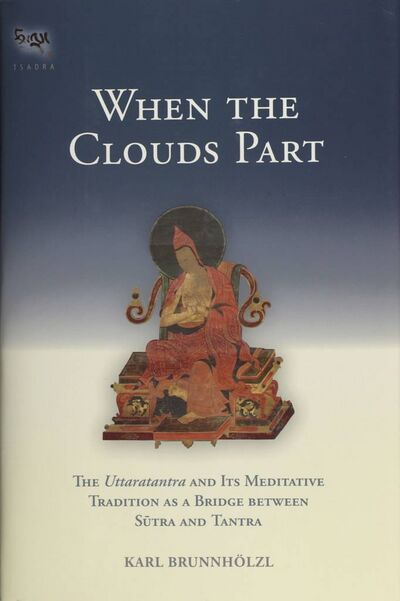|
|
| (78 intermediate revisions by 5 users not shown) |
| Line 1: |
Line 1: |
| {{BookCall}} | | {{Book |
| | |BookPerson={{Book-person |
| | |PersonPage=Maitreya |
| | |PersonName=Maitreya |
| | }}{{Book-person |
| | |PersonPage=Brunnhölzl, K. |
| | |PersonName=Karl Brunnhölzl |
| | }} |
| | |FullTextRead=Yes |
| | |FullTextLink=/Contents |
| | |FullTextLinkLabel=Read it now |
| | |TextTranslated=Texts/Ratnagotravibhāga Mahāyānottaratantraśāstra |
| | |VideoService=vimeo |
| | |VideoId=225908764 |
| | |BookEssay=<em>When the Clouds Part</em> is a translation and study of the ''Uttaratantra'', also known as the ''Ratnagotravibhāga'', and nine related texts from India and Tibet, some translated for the very first time in this publication. It is not the first translation of the text—Brunnhölzl cites two previous English translations by Obermiller (1931) and Takasaki (1958), who translated from Sanskrit and Tibetan, and Sanskrit, Tibetan, and Chinese, respectively. |
| | |
| | The book begins with a 325-page "Translator's Introduction," a study of the sutra's sources and exegetical traditions, which is a tour de force and a major reference for buddha-nature studies. It is for highly educated readers, assuming an extensive familiarity with the issues and terms of the discussion, such as the Madhyamaka/Yogācāra divide and the doctrine of tathāgatagarbha. |
| | |
| | The Translator's Introduction is divided into eight sections: (1) the sūtra sources for tathāgatagarbha teachings; (2) historical survey of Indian and Tibetan definitions of tathāgatagarbha; (3) the history of the transmission of the "Five Books of Maitreya" to Tibet; (4) a survey of explanations of the meaning of the title of the ''Uttaratantra''; (5) the relationship between the ''Uttaratantra'' and Yogācāra; (6) the ''Uttaratantra'' and ''zhentong''; (7) the ''Uttaratantra'' and Mahāmudrā; (8) and an outline and summary of the ten works translated. |
| | |BookToc=*{{i|Abbreviations|ix}} |
| | *{{i|Preface|xi}} |
| | *{{i|Acknowledgments|xiii}} |
| | <center>Translator's Introduction 1</center> |
| | *{{i|The Sūtra Sources of the ''Tathāgatagarbha'' Teachings|3}} |
| | *{{i|[[Books/When_the_Clouds_Part/Different_Ways_of_Explaining_the_Meaning_of_Tathāgatagarbha|Different Ways of Explaining the Meaning of ''Tathāgatagarbha'']]|53}} |
| | **{{i|Explanations of ''Tathāgatagarbha'' in Indian Texts|54}} |
| | ***{{i|''Tathāgatagarbha'' as the Emptiness That Is a Nonimplicative Negation|55}} |
| | ***{{i|''Tathāgatagarbha'' as Mind’s Luminous Nature|57}} |
| | ***{{i|''Tathāgatagarbha'' as the Ālaya-Consciousness|63}} |
| | ***{{i|''Tathāgatagarbha'' as a Sentient Being|63}} |
| | ***{{i|''Tathāgatagarbha'' as the Dharmakāya, Suchness, the Disposition, and<br>{{6nbsp}}Nonconceptuality|64}} |
| | **{{i|Tibetan Assertions on ''Tathāgatagarbha''|65}} |
| | *{{i|The History and Transmission of "The Five Dharmas of Maitreya" from<br>{{6nbsp}}India to Tibet|81}} |
| | *{{i|The ''Mahāyānottaratantra'' (''Ratnagotravibhāga'') and the<br>{{6nbsp}}''Ratnagotravibhāgavyākhyā''|93}} |
| | **{{i|Texts and Authorships|93}} |
| | **{{i|The Meanings of the Titles ''Ratnagotravibhāga'' and<br>{{6nbsp}}''Mahāyānottaratantraśāstra''|95}} |
| | *{{i|The ''Uttaratantra'' and Its Relationship with Yogācāra|105}} |
| | *{{i|The Meditative Tradition of the ''Uttaratantra'' and Shentong|123}} |
| | **{{i|The Two Approaches of Explaining the ''Uttaratantra''|123}} |
| | **{{i|The Shentong Lineages and the Meditative Tradition of the<br>{{6nbsp}}''Uttaratantra'' in the Jonang, Kagyü, and Nyingma Schools|131}} |
| | **{{i|Indian Forerunners of Shentong, Early Tibetan Shentongpas, and Their<br>{{6nbsp}}Connection to the ''Uttaratantra''|140}} |
| | *{{i|The ''Uttaratantra'' and Mahāmudrā|151}} |
| | **{{i|Sūtra Mahāmudrā, Tantra Mahāmudrā, and Essence Mahāmudrā|151}} |
| | **{{i|The Sūtra Sources of Mahāmudrā|165}} |
| | **{{i|Maitrīpa’s Mahāmudrā of "Mental Nonengagement"|167}} |
| | **{{i|Connections between Maitrīpa’s Mahāmudrā and the ''Uttaratantra''|177}} |
| | **{{i|Other Indian Nontantric Treatises on Mahāmudrā|184}} |
| | **{{i|Gampopa’s Mahāmudrā and the ''Uttaratantra''|190}} |
| | **{{i|The Third Karmapa, Rangjung Dorje|202}} |
| | **{{i|The Eighth Karmapa, Mikyö Dorje|206}} |
| | **{{i|Tagpo Dashi Namgyal|212}} |
| | **{{i|Padma Karpo|214}} |
| | **{{i|The Eighth Situpa, Chökyi Jungné|216}} |
| | **{{i|Other Kagyü Masters on Mahāmudrā and the ''Uttaratantra''|227}} |
| | **{{i|Gö Lotsāwa’s Unique Mahāmudrā Interpretation of the ''Uttaratantra''|243}} |
| | **{{i|The Geden Kagyü Tradition of Mahāmudrā|278}} |
| | *{{i|Overview of the Indian and Tibetan Texts Presented in This Book|283}} |
| | **{{i|The ''Uttaratantra'' and Ratnagotravibhāgavyākhyā|283}} |
| | **{{i|The Indian Texts on the ''Uttaratantra''|288}} |
| | **{{i|The Tibetan Commentaries|301}} |
| | **{{i|Instruction Manuals|314}} |
| | <center>Translations 329</center> |
| | *{{i|''Ratnagotravibhāga Mahāyānottaratantraśāstra—An Analysis of the Jewel Disposition, A<br>{{6nbsp}}Treatise on the Ultimate Continuum of the Mahāyāna''|331}} |
| | **{{i|Chapter 1: The Three Jewels and the Tathāgata Heart|337}} |
| | **{{i|Chapter 2: Awakening|415}} |
| | **{{i|Chapter 3: The Buddha Qualities|429}} |
| | **{{i|Chapter 4: Buddha Activity|437}} |
| | **{{i|Chapter 5: The Benefit|455}} |
| | |
| | *{{i|''Pith Instructions on "The Treatise on the Ultimate Continuum of the<br>Mahāyāna"'' by Sajjana|461}} |
| | |
| | *{{i|''A Commentary on the Meaning of the Words of the "Uttaratantra"''|473}} |
| | |
| | *{{i|''A Commentary on "The Treatise on the Ultimate Continuum of the<br>Mahāyāna," The Heart of the Luminous Sun'' by Dashi Öser|695}} |
| | |
| | *{{i|''Instructions on "The Ultimate Continuum of the Mahāyāna"'' by Mönlam<br>Tsültrim|777}} |
| | |
| | *{{i|''The Repository of Wisdom'' by Mönlam Tsültrim|789}} |
| | |
| | *{{i|''The Heart of the Matter of Luminosity'' by Mönlam Tsültrim|797}} |
| | |
| | *{{i|''Pith Instructions on the Wisdom at the Point of Passing when about to<br>Die'' by Mönlam Tsültrim|801}} |
| | |
| | *{{i|''The Lamp That Excellently Elucidates the System of the Proponents of<br>Shentong Madhyamaka'' by the Eighth Karmapa|803}} |
| | |
| | *{{i|''Guiding Instructions on the View of Great Shentong Madhyamaka— Light<br>Rays of the Stainless Vajra Moon'' by Jamgön Kongtrul|831}} |
| | |
| | *{{i|Appendix 1: Selected Indian and Tibetan Comments on ''Uttaratantra'' I.27–2|855}} |
| | |
| | *{{i|Appendix 2: Selected Indian and Tibetan Comments on ''Uttaratantra'' I.154–5|901}} |
| | |
| | *{{i|Appendix 3: Indian and Tibetan Comments on ''Abhisamayālaṃkāra'' V.2|943}} |
| | |
| | *{{i|Appendix 4: The Emptiness Endowed with All Supreme Aspect|953}} |
| | |
| | *{{i|Appendix 5: The General Explanation of ''Tathāgatagarbha'' in Yeshé Dorje's<br>Commentary on the ''Uttaratantra''|963}} |
| | |
| | *{{i|Appendix 6: The Presentation of the Purpose of Teaching ''Tathāgatagarbha'' in<br>Yeshé Dorje's Commentary on the ''Uttaratantra''|969}} |
| | |
| | *{{i|Appendix 7: Comparison of the First Six Topics of the Fourth and Fifth Vajra<br>Points in the ''Uttaratantra'' with the Same Six Topics in the ''Mahāyānasūtrā-<br>laṃkāra'' and the ''Mahāyānasaṃgraha''|979}} |
| | |
| | *{{i|Appendix 8: ''A Letter from Stainless Expanse and Awareness— a Casual<br>Summary of the "Uttaratantra"''|983}} |
| | |
| | *{{i|Notes|985}} |
| | *{{i|English–Sanskrit–Tibetan Glossary|1227}} |
| | *{{i|Tibetan–Sanskrit–English Glossary|1231}} |
| | *{{i|Selected Bibliography|1235}} |
| | *{{i|Index|1259}} |
| | |AddRelatedTab=Yes |
| | |QuotesTabContent={{GetBookQuotes}} |
| | |PublisherLogo=File:Snow Lion logo.png |
| | |ExtraCategories=Tsadra Foundation Series |
| | |StopPersonRedirects=No |
| | |BookParentPage=Secondary Sources |
| | |AddQuotesTab=Yes |
| | }} |



